Author: Associate Vice President, Analytics and Data Strategy, Quantzig.
Table of Contents
Introduction to Micro Marketing Segmentation
In today’s highly competitive business landscape, understanding and engaging with customers on a personalized level has become paramount for success. Micro-segmentation is a powerful technique that allows businesses to dissect their customer base into granular segments, enabling targeted and tailored marketing strategies based on near real-time data. This data-driven precision not only enhances customer engagement and satisfaction but also drives improved conversion rates and business growth. Through this comprehensive article, we’ll explore the transformative impact of customer micro-segmentation on marketing effectiveness.
Book a demo to experience the meaningful insights we derive from data through our analytical tools and platform capabilities. Schedule a demo today!
Request a Free DemoWhat is Customer Micro-Segmentation?
The practice of breaking down a company’s customer base into groups pertinent to a specific business is known as customer micro-segmentation. Determining how to interact with consumers in each segment to optimize their value to the company is customer segmentation. A more sophisticated segmentation called micro-segmentation divides a few clients into accurate groups according to a variety of criteria, such as behavioral predictions. To optimize the efficiency of each customer interaction, marketers can target marketing initiatives at each micro-segment.
What is the Difference Between Micro and Macro Segmentation?
In customer segmentation, two main strategies stand out: macro and micro segmentation. The distinction between these approaches lies in the level of granularity required for each. Macro segmentation focuses on high-level customer data such as location, language, or source, whereas micro segmentation delves into customer-specific data such as preferred products, brand history, and time since last purchase.
As a result, the segments generated by these strategies differ significantly in terms of size and homogeneity. Macro segmentation typically yields larger segments with a higher level of heterogeneity, making it challenging for marketers to implement personalized marketing strategies. In contrast, micro segmentation results in smaller, highly homogeneous segments with fewer customers.
While marketers often begin by employing macro segmentation strategies, as they mature and become more sophisticated, they tend to transition to micro segmentation as their core strategy.
Understanding the Types of Customer Micro Segmentation
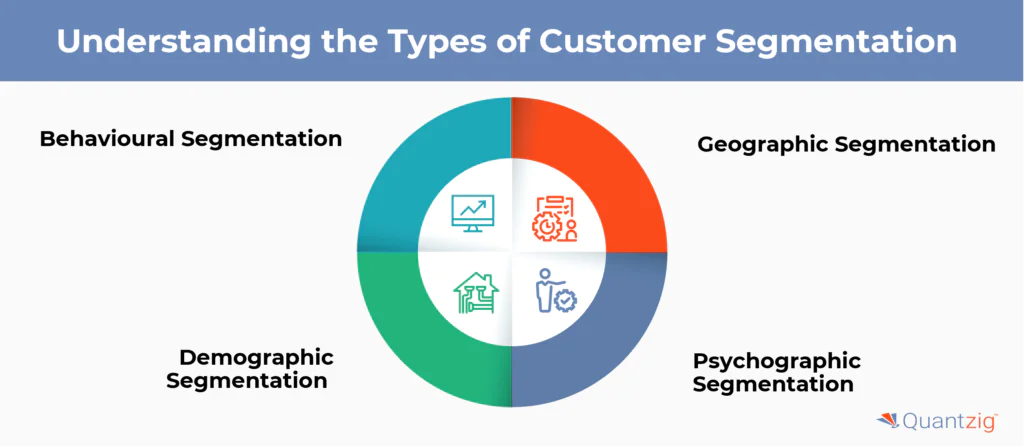
To effectively segment customers, it is essential to understand the various techniques and strategies involved. Here, we will explore the four primary categories of segmentation: behavioral, geographic, demographic, and psychographic. Each of these categories can be further divided into more specific micro-segments, allowing for a more detailed understanding of customer preferences and behaviors.
1. Behavioral Segmentation
Behavioral segmentation focuses on the actions and behaviors of customers. This includes identifying window shoppers, repeat buyers, and those with specific purchase intentions. By analyzing these behaviors, businesses can tailor their marketing strategies to better engage with these groups.
2. Geographic Segmentation
Geographic segmentation categorizes customers based on their location. This includes dividing customers by nation, state, city, and metropolitan area. Additionally, businesses can further segment based on environmental factors such as climate, urbanity, and rural or semi-urban settings.
3. Demographic Segmentation
Demographic segmentation involves categorizing customers based on socio-personal characteristics such as age, gender, religion, education, and income. This helps businesses understand the needs and preferences of their customers in a more detailed manner.
4. Psychographic Segmentation
Psychographic segmentation focuses on personality traits and values. This includes categorizing customers based on their interests, such as fantasy book readers or avid travelers, as well as their technological proficiency, fashion preferences, and other lifestyle choices.
What is the Importance of Effective Micro Marketing Segmentation?
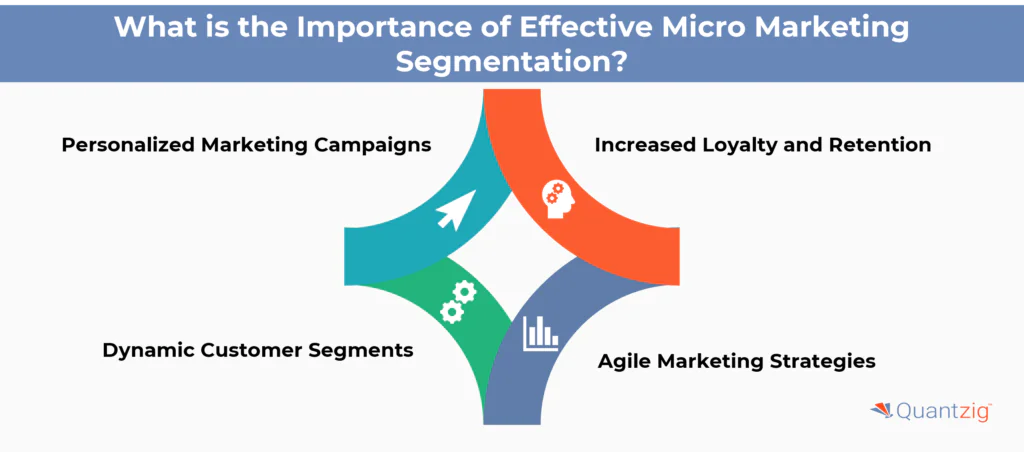
1. Personalized Marketing Campaigns
Effective customer marketing with customer micro-marketing segmentation empowers businesses to develop a deeper understanding of individual customer needs and preferences based on their journey with the brand. By analyzing vast datasets and customer interactions, businesses can identify critical touchpoints, pain points, and preferences along the customer journey. This data-driven approach allows for the creation of personalized marketing campaigns, tailored product recommendations, and targeted promotions, enhancing customer engagement and satisfaction.
2. Increased Loyalty and Retention
Understanding customers on an individual level leads to increased loyalty, improved customer retention, and higher conversion rates. Embracing micro-segmentation is vital in today’s competitive landscape, as it enables businesses to build lasting relationships with their customers and gain a competitive edge in the market.
3. Dynamic Customer Segments
Effective customer marketing with customer analytics and segmentation allows businesses to implement dynamic customer segment, based on the latest interactions across various marketing channels. This data-driven approach enables real-time tracking of customer behaviors, preferences, and responses, leading to a comprehensive understanding of changes in customer mindset. By constantly updating customer segments based on the latest data, businesses can deliver highly personalized and relevant marketing campaigns, maximizing customer engagement and satisfaction.
4. Agile Marketing Strategies
Understanding changes in customer mindset is crucial for businesses to adapt quickly to shifting market dynamics and customer preferences. Embracing micro-marketing segmentation facilitates agile and effective marketing strategies; ensuring businesses stay ahead of the competition and foster lasting relationships with their customers, ultimately driving business growth and success.
Challenges Present in a Lack of Effective Customer Micro Marketing Segmentation

1. Siloed Data and Lack of Unified Approach
Today, businesses struggle to effectively market to their customers despite access to multiple channels of outreach and increased promotion budgets. This is primarily owing to siloed data across marketing teams and the resistance from individual teams to adopt a unified assessment approach. Individual marketing teams tend to operate independently, believing that their specific channel requires unique strategies to impact customers effectively. Each marketing team reaches out to customers based on their understanding of customer needs, being completely agnostic to customer journey with brand across channels and any recent preference/behavioral changes. This results in multiple brand messages with varied CTAs going to the same customer leading to poor customer experience.
2. Missed Opportunities for Cross-Channel Collaboration
Without micro-marketing segmentation, businesses struggle to create personalized campaigns that resonate with individual customers. Furthermore, the absence of a unified approach leads to missed opportunities for cross-channel collaboration, resulting in suboptimal customer engagement and limited ROI. Embracing micro-segmentation breaks down data silos, fosters collaboration, and enables businesses to deliver highly targeted marketing efforts that drive customer satisfaction and loyalty.
What are the Benefits of Effective Customer Micro Marketing Segmentation?
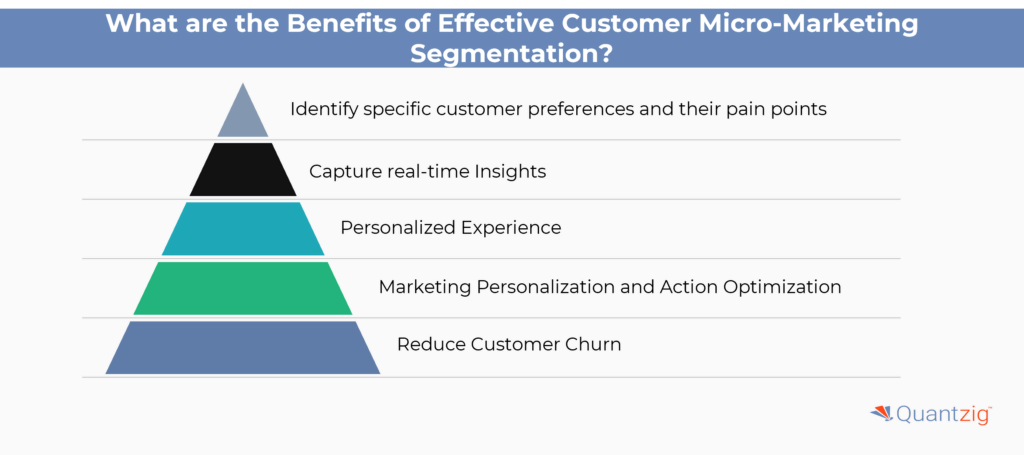
- Identify Customer Preferences and Pain Points
Micro Marketing Segmentation and Market Segmentation Strategies help businesses identify customer preferences and pain points, creating targeted marketing campaigns. Through customer segmentation and segmentation analysis, companies can enhance personalized marketing, driving engagement and loyalty. Utilizing consumer behavior analysis and data-driven marketing helps businesses achieve long-term growth.
- Capture Real-Time Insights
Using microtargeting techniques and audience targeting, companies capture real-time insights into customer behavior. This agility allows businesses to choose the best channel for engagement, boosting ROI. By incorporating market research tools and B2B segmentation strategies, companies can continuously refine their approaches to match evolving customer actions.
- Personalized Experience
Behavioral segmentation, demographic segmentation, and psychographic segmentation help businesses craft custom marketing campaigns tailored to individual preferences. Niche marketing and geographic segmentation strategies deliver a highly personalized marketing experience. With AI tools and predictive analysis, businesses anticipate customer needs, fostering loyalty and stronger connections.
- Marketing Personalization and Action Optimization
Through segmentation models and market trends analysis, companies can optimize marketing actions to target the right customer at the right time. Segment-specific strategies and target audience insights enhance both B2B segmentation strategies and B2C segmentation approaches, improving campaign effectiveness and ROI.
- Reduce Customer Churn
By leveraging segmentation criteria and customer profiling, businesses can identify at-risk customers. Proactive measures supported by predictive tools reduce churn, improve customer lifetime value, and create a stable, profitable customer base.
Also Read: Understanding Omnichannel Marketing Analytics for Businesses
Get started with your complimentary trial today and delve into our platform without any obligations. Explore our wide range of customized, consumption driven analytical solutions services built across the analytical maturity levels.
Start your Free Trial TodayHow to Establish Micro Marketing Segmentation?
Establishing micro-segmentation marketing involves a strategic approach to dividing your customer base into smaller, highly specific groups based on shared characteristics. Here are the key steps:
- Identify Your Target Audience: Determine the demographics, behaviors, and preferences of your customers to create a comprehensive understanding of your target audience.
- Collect Customer Data: Gather data on customer demographics, purchase history, and behavioral patterns to create a robust database.
- Create Micro-Segments: Use data analysis to identify specific groups within your customer base that share similar characteristics, such as age, location, or interests.
- Develop Targeted Campaigns: Design marketing campaigns tailored to each micro-segment, using personalized messages and offers that resonate with their specific needs and preferences.
- Monitor and Refine: Continuously monitor the effectiveness of your micro-segmentation strategy and refine it as needed to ensure optimal results.
By following these steps, you can create targeted marketing campaigns that drive engagement, conversion, and revenue growth, ultimately enhancing customer satisfaction and loyalty.
Driving Customer Marketing Success through Micro-marketing Segmentation: A Quantzig Case Study
| Category | Details |
|---|---|
| Client Details | A leading healthcare, nutrition, and personal care brand based in the United States with annual revenue of $10bn+. |
| Challenges Faced by The Client | The client faced significant challenges in understanding customer interactions across various marketing channels due to disconnected data, making it difficult to trace the customer journey and develop personalized marketing strategies, resulting in missed opportunities for customer engagement and increased customer churn. |
| Solutions Offered by Quantzig | Quantzig’s customer 3.0 framework leveraged advanced identity resolution techniques to build a comprehensive 360-degree customer profile, enabling the creation of a unified customer journey map and personalized marketing tactics to increase customer retention and reduce churn. |
| Impact Delivered | 13% higher customer engagement 7.5% higher sales 11% increase in revenue from existing customers |
Client Details:
A leading healthcare, nutrition, and personal care brand based in the United States with annual revenue of $10bn+.
Challenges Faced by the Client:
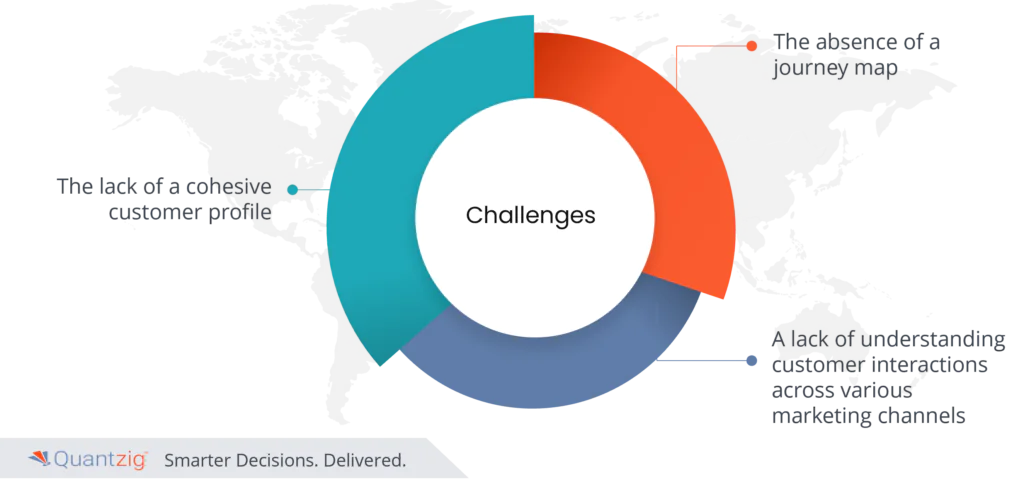
A leading e-commerce retailer in the USA faced significant challenges in understanding customer interactions across various marketing channels. Disconnected data made it difficult to trace the customer journey, hindering the development of personalized marketing strategies. The lack of a cohesive customer profile and journey map resulted in missed opportunities for customer engagement and increased customer churn.
Customer Micro-Marketing Segmentation Solutions Offered by Quantzig:
Quantzig, a global data analytics and strategic consulting firm, offered a transformative solution through its customer 3.0 framework. By leveraging advanced identity resolution techniques, we built a comprehensive 360-degree customer profile, connecting customer data from diverse channels. This enabled the client to create a unified customer journey map, identifying potential re-activation and potential churn points. Utilizing predictive analytics, the next-best action for each customer was determined, allowing for highly personalized marketing tactics to help increase customer retention and reduce churn.
Impact Delivered from Customer Micro-Marketing Segmentation:
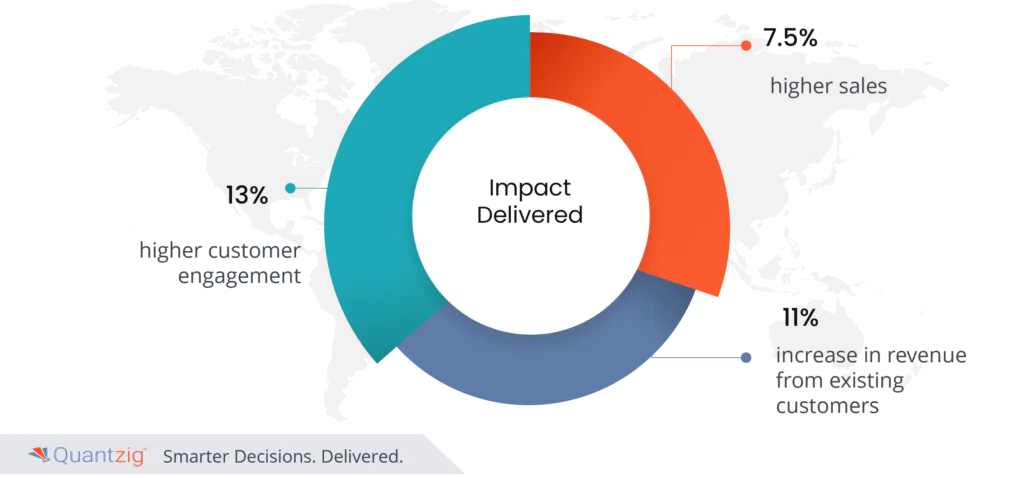
- 13% higher customer engagement
- 7.5% higher sales
- 11% increase in revenue from existing customers
Quantzig’s Unique Approach to Customer Micro-Segmentation
Quantzig’s customer micro-segmentation solution leverages advanced AI tools and predictive analysis to enhance customer segmentation. This approach enables businesses to understand customer behavior changes, enabling personalized and impactful marketing tactics. By identifying the next-best action and the best marketing channel for each customer at a given point in their journey, businesses can tailor their messaging and offers, enhancing customer satisfaction and loyalty.
Key Features:
- Advanced AI tools for data analysis
- Predictive analytics for identifying next-best actions
- Real-time insights for personalized marketing
- Data-driven precision for targeted campaigns
- Enhanced customer satisfaction and loyalty
Why Choose Quantzig?
- 17 years of experience in data analytics and strategic consulting
- 1500 in-depth solutions delivered across various industries
- Proven track record of driving business growth and success
Quantzig’s unique approach to customer micro-segmentation empowers businesses to drive customer engagement and conversions to new heights. By leveraging advanced AI tools and predictive analysis, businesses can tailor their marketing strategies to individual customer needs, enhancing customer satisfaction and loyalty.
Also Read: Guide to Advanced Marketing Analytics Solutions and Its Business Benefits
Experience the advantages firsthand by testing a customized complimentary pilot designed to address your specific requirements. Pilot studies are non-committal in nature.
Request a Free PilotConclusion
In conclusion, effective customer marketing with customer micro-segmentation emerges as a game-changing strategy for businesses seeking to drive customer engagement and conversions to new heights. Through real-time insights and data-driven precision, a customer segmentation system empowers businesses to understand customer behavior changes, enabling personalized and impactful marketing tactics. By identifying the next-best action and the best marketing channel for each customer at a given point in their journey, businesses can tailor their messaging and offers, enhancing customer satisfaction and loyalty. Embracing micro-segmentation positions businesses as agile market leaders, delivering targeted campaigns that resonate with customers across various channels.




